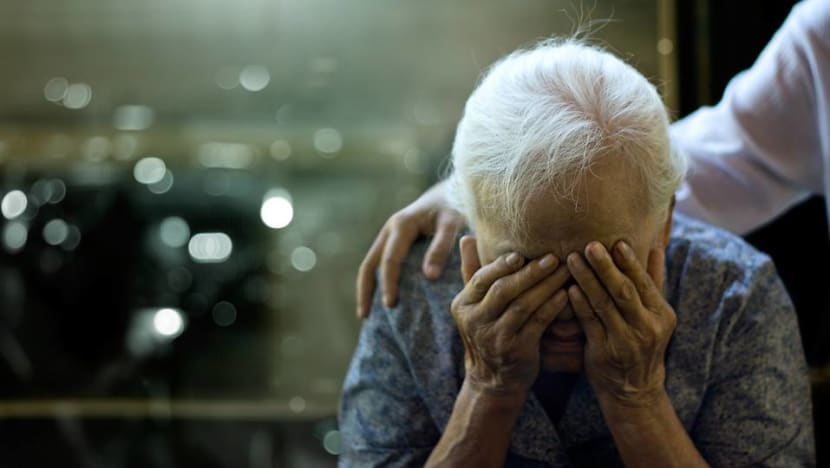Commentary: Heeding cries for help – getting to the heart of elderly suicides requires more than counselling
The elderly experience a unique set of stresses making them especially prone to depression and suicide risk. SUSS’ Dr Helen Ko reveals unexpected networks that can help prevent this.

Physical disability, mental illnesses such as depression, and life stressors intensify the risk of suicides among seniors. (Photo: iStock/ipopba)
SINGAPORE: The Samaritans of Singapore (SOS) recently reported a rise of 13 per cent in the overall number of suicides last year, compared to 2019, the highest numbers since 2012.
The increase occurred across age groups, but the spike of 26 per cent by seniors, the highest number of suicides since 1991, is alarming.
Moreover, while the number of cases in this category has risen, the number of calls for help received from this group has decreased compared to 2019, suggesting our seniors experience distress but are not coming forward to seek help.
More troubling is the underlying link between age and suicide rates. In Singapore, there were 8.91 suicides per 100,000 for all ages in 2017, a figure that is 24.06 per 100,000 for those aged 70 or older in the same year.
Physical disability, mental illnesses such as depression, and life stressors intensify the risk of suicides among seniors.
We also know Singaporeans are generally living longer but spending more years in poor physical health as a result of heart diseases, stroke and cancer, according to the Singapore’s Ministry of Health.
Older adults also typically experience multiple losses within a short span of time, when friends pass on in succession, tensions in marital relationships as caregiving burden strains couples, and financial concerns.
COVID-19 has accentuated these issues considerably. With heightened restrictions on social gatherings, face-to-face social activities at senior care centres and community clubs, and visitors at nursing homes, seniors found themselves suddenly having to cope alone and separated from loved ones.
Add to this the pervasive use of technological platforms and gadgets for tracing and testing, as well as social connection, lower-income seniors living by themselves are particularly hard hit.
Then there are shifts in emotions. If they have ailments and depend on others, they often develop a heightened sense of awareness of their bleak future. They feel like a burden. These often escalate to existential concerns where they question the meaning in continuing living.
Considering also recent reports showing older workers aged 50 experiencing the largest increase in retrenchment in 2020 and that retiree households were hardest hit by inflation, there is greater urgency to address this issue.
HELP AVAILABLE TO SENIORS
It is fortunate therefore that Community Outreach Teams, which tap on neighbours and volunteers to reach out to vulnerable seniors, have been formed through partnerships by the Ministry of Health, Agency for Integrated Care (AIC) and Social Service Agencies. Family and friends are encouraged to identify and refer their loved ones for help.
The hope is these outreach efforts can promote greater understanding of risk factors and the profile of at-risk seniors, tackling the issue of elder suicide with concerted efforts of multiple stakeholders, through a multi-level, multi-pronged strategy.
The Government recognises that early risk detection is key to preventing suicides. It recommended comprehensive risk assessments which include variables such as demographics, suicide history, an elderly presenting suicide ideations and plans, and other risk factors.
Multiple organisations, including hospitals, community-based and governmental agencies such as the AIC have been established to provide more holistic support for at-risk seniors.
Other initiatives like the Community Psychogeriatric Programme, where immobile elderly with mental health issues could receive treatment at home, have also been established.
To shift mindsets and boost public education, the National Council of Social Service also launched Beyond the Label, a campaign to clarify myths and address mental health stigmas. But the question is to what extent have the messages of this campaign reached seniors and their caregivers?
On the criminal justice front, the decriminalisation of suicide since January 2020 is a step in the right direction, since people who have attempted suicide are more likely to seek help for mental health if they do not have to fear prosecution.
TAPPING INTO SOCIAL NETWORKS
Despite these laudable efforts to reach out to seniors, the statistics show a stark reality in Singapore. If we listen closely, we may discover the warning signs and opportunities for intervention may have been there all along.
Typically, seniors who have suffered multiple losses such as the passing of family members and isolation are more likely to seek help from their general practitioners than from social service professionals.
This is also why we hear about seniors complaining of physical pain despite doctors being unable to diagnose a reason.
Within the cultural context of Singapore, it is generally more acceptable for older adults to verbalise physical pains and illnesses than to admit some sense of depression, which may be perceived as a moral failing or a lack of resilience.
Older men, in particular, may feel a need to present a stoical front. They also tend to express less emotions and avoid seeking help or through disengagement. This could be a reason why the number of suicides among older men outnumber that of older women by about two to one.
Against this cultural backdrop, there should be more targeted training of frontline healthcare professionals in primary healthcare such as the polyclinics and family clinics.
The training should cater for not only doctors, general practitioners, nurses, allied healthcare professionals such as physiotherapists and occupational therapists, but include TCM practitioners and pharmacists stationed at retail stores, as these typically come into frequent contacts with seniors.
Frontline professionals should be equipped with appropriate communication skills to asses suicide risk and be able to employ suitable tools for that purpose.
Existing suicide risk assessment tools could also be reviewed. Currently, some health and social service professionals utilise internationally validated, age-specific psychometric tools to assess suicide risks of seniors and for planning follow-up care.
However, due to busy clinical settings, these are often not administered. Hence, where feasible, these tools should be abbreviated and fine-tuned. A useful tool may be the five-item Geriatric Suicide Ideation Scale-Screen, derived from its 30-item Scale, and be adapted for the local context.
Additionally, further research to develop culturally and ethnically appropriate risk assessment tools that considers the religious dimensions should also be carried out to enhance efficacy.
Thus far, it appears that religious leaders have not been specifically targeted to identify at- risk elderly. This group constitutes an important resource and should be tapped. From my experience, many depressed seniors do seek comfort and solace from their spiritual leaders and faith communities.
Those who work in religious services can pay attention to seniors who may be crying for help. Deriving strength through prayer and regular attendance at church, temple or mosque is an integral part of the lives of many older adults, and seniors may seek aid in times of pandemic or other types of stress.
Being able to detect warning signs and furnish seniors with information on community support services, including referral processes and contact numbers could be a life-saver.
By 2030, one in four Singaporeans will be aged 65 and above. The intersection of the vicissitudes of ageing: Physical illnesses, mental health issues and various life-stressors, compounded by the pandemic accentuating their sense of loneliness and social isolation, will likely further increase the suicide risks of seniors.
Seniors are an integral part of our society. They are as valuable and as deserving as any other age-group to benefit from all the services and facilities that our society can offer.
Many could also contribute back to society with their rich experience. Urgent and concrete actions are therefore required to address why many of them decide that life is not worth living.
Dr Helen Ko is Associate Professor, Master and PhD in Gerontology Programmes at the Singapore University of Social Sciences (SUSS) and concurrently Executive Director of Beyond Age, a silver workforce training consultancy. She was previously Chief Executive Officer of St Luke’s Eldercare and Executive Director at the Centre for Seniors.



















